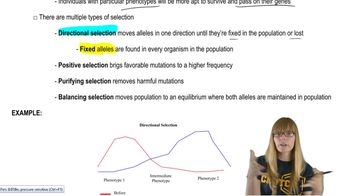Table of contents
- 1. Introduction to Genetics51m
- 2. Mendel's Laws of Inheritance3h 37m
- 3. Extensions to Mendelian Inheritance2h 41m
- 4. Genetic Mapping and Linkage2h 28m
- 5. Genetics of Bacteria and Viruses1h 21m
- 6. Chromosomal Variation1h 48m
- 7. DNA and Chromosome Structure56m
- 8. DNA Replication1h 10m
- 9. Mitosis and Meiosis1h 34m
- 10. Transcription1h 0m
- 11. Translation58m
- 12. Gene Regulation in Prokaryotes1h 19m
- 13. Gene Regulation in Eukaryotes44m
- 14. Genetic Control of Development44m
- 15. Genomes and Genomics1h 50m
- 16. Transposable Elements47m
- 17. Mutation, Repair, and Recombination1h 6m
- 18. Molecular Genetic Tools19m
- 19. Cancer Genetics29m
- 20. Quantitative Genetics1h 26m
- 21. Population Genetics50m
- 22. Evolutionary Genetics29m
7. DNA and Chromosome Structure
RNA
Problem 18
Textbook Question
Textbook QuestionList three main differences between DNA and RNA.
 Verified Solution
Verified SolutionThis video solution was recommended by our tutors as helpful for the problem above
Video duration:
1mPlay a video:
Was this helpful?
Key Concepts
Here are the essential concepts you must grasp in order to answer the question correctly.
Structure
DNA (deoxyribonucleic acid) is typically double-stranded, forming a double helix, while RNA (ribonucleic acid) is usually single-stranded. The sugar in DNA is deoxyribose, whereas RNA contains ribose. Additionally, DNA uses thymine as one of its nitrogenous bases, while RNA substitutes uracil for thymine.
Recommended video:
Guided course

Ribosome Structure
Function
DNA serves as the long-term storage of genetic information, acting as a blueprint for all living organisms. In contrast, RNA plays a crucial role in translating that genetic information into proteins, with messenger RNA (mRNA) carrying the code from DNA to ribosomes, where proteins are synthesized.
Recommended video:
Guided course

Functional Genomics
Stability
DNA is more stable than RNA due to its double-stranded structure and the absence of a hydroxyl group on the 2' carbon of its sugar, making it less prone to hydrolysis. RNA, being single-stranded and containing ribose, is more reactive and less stable, which is suitable for its transient roles in the cell.
Recommended video:
Guided course

Natural Selection
Related Videos
Related Practice




